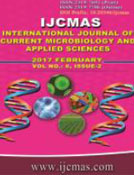


 National Academy of Agricultural Sciences (NAAS)
National Academy of Agricultural Sciences (NAAS)

|
PRINT ISSN : 2319-7692
Online ISSN : 2319-7706 Issues : 12 per year Publisher : Excellent Publishers Email : editorijcmas@gmail.com / submit@ijcmas.com Editor-in-chief: Dr.M.Prakash Index Copernicus ICV 2018: 95.39 NAAS RATING 2020: 5.38 |
A field experiment was conducted during rabi season of 2013-14 to study the performance of wheat under different planting methods with varied row spacing and herbicides. Experiment was laid out in split-plot design having six planting methods [bed planting with two and three rows, drill sowing at 18 and 20 cm (conventional tillage), drill sowing at 18 and 20 cm (zero tillage)] as main-plot treatments and five herbicidal treatments [pinoxaden 50 g/ha, {carfentrazone + metsulfuron (RM)} 25 g/ha, pinoxaden + {carfentrazone + metsulfuron (RM)} (50+25g)/ha, weed free and weedy check] as subplot treatments replicated thrice. Various planting methods resulted in significant difference in population and dry matter accumulation by weeds from 60 DAS to harvest. Maximum wheat yield and minimum numbers of weeds and their lowest dry matter accumulation were observed in zero tillage, whereas, lower wheat yield and maximum number of weeds and their highest dry matter accumulation were observed in bed planting method. Density of weeds and their dry matter accumulation increased with increasing row spacing from 18 cm (drill sowing both in ZT and CT) to 35 cm (bed planting with two rows), whereas, the crop yield increased with decreased row spacing. Among the various herbicidal treatments, the combined application of pinoxaden + [carfentrazone + metsulfuron (RM)] (50+25 g) /ha was most effective against both grassy and broadleaf weeds with more than 90 per cent weed control efficiency (WCE %). Pinoxaden 50 g/ha, significantly reduced the population and dry matter accumulation of grassy weeds having 93 per cent WCE for grassy weeds, whereas, application of carfentrazone + metsulfuron (RM) (25 g/ha), significantly reduced the population and dry matter accumulation of all broad leaved weeds with more than 95 per cent WCE.
 |
 |
 |
 |
 |